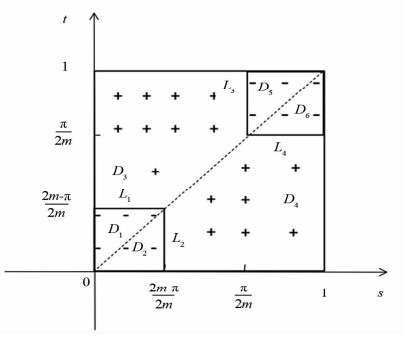-
非线性二阶常微分方程Neumann问题具有广泛的物理背景,对此类问题的研究已经取得了许多结果[1-11].但许多学者在研究非线性二阶Neumann问题正解的存在性时,都是在格林函数大于0的情形下研究的[1-7].特别地,文献[1]在$m \in \left( {0,\;\frac{{\rm{\pi }}}{2}} \right)$的条件下研究了二阶常微分方程Neumann问题
基于锥
运用锥拉伸与压缩不动点定理,得到问题(1)至少存在1个正解,其中非线性项f满足超线性或次线性条件,A,B分别表示问题(1)对应的齐次问题的格林函数的最小值和最大值,且A,B均大于0.
进一步,文献[2]对问题(1)中的非线性项f提出了新的约束条件,运用Leggett-Williams不动点定理,在$m \in \left({0, \frac{{\rm{ \mathsf{ π} }}}{2}} \right)$的条件下,得到问题(1)至少存在3个非负解,其中f∈C([0, 1]×[0,∞),[0,∞))且存在常数a,d,使得0 < d < a,且
或
这里$m \in \left({0, \frac{{\rm{ \mathsf{ π} }}}{2}} \right)$保证了问题(1)的格林函数大于0,但是在格林函数变号的情况下此类问题的研究较少.
注意到:当问题(1)中$m = \frac{{\rm{ \mathsf{ π} }}}{2} + \frac{1}{n} \in \left({\frac{{\rm{ \mathsf{ π} }}}{2}, \frac{{\rm{ \mathsf{ π} }}}{2} + {\rm{ \mathsf{ ε} }}} \right)$,且${G_m}(0, 0) < 0, {G_m}\left({\frac{1}{2}, \frac{1}{2}} \right) > 0$,即问题(1)的格林函数变号.现在的问题是:当格林函数变号时,二阶Neumann问题是否存在正解?基于此,本文将运用Schauder不动点定理考察二阶Neumann问题
正解的存在性,其中λ是正参数,$m \in \left({\frac{{\rm{ \mathsf{ π} }}}{2}, \frac{{\rm{ \mathsf{ π} }}}{2} + {\rm{ \mathsf{ ε} }}} \right), {\rm{ \mathsf{ ε} }} > 0$充分小.
记Gm(t,s)是问题(2)对应的齐次问题
的格林函数,则
令Gm(t,s)=Gm+(t,s)-Gm-(t,s),其中
本文总假定:
(H1) f:[0,∞)→$\mathbb{R} $为连续函数且f(0)>0;
(H2) g:[0, 1]→$\mathbb{R} $+连续且在(0,1)的任一子区间内不恒为0;
(H3) 存在常数k>0,使得$\int_0^1 {G_m^ + } (t, s)g(s){\rm{d}}s \ge (1 + k)\int_0^1 {G_m^ - } (t, s)g(s){\rm{d}}s, t \in [0, 1]$.
引理1 问题(2)对应的齐次问题的格林函数Gm(t,s)在(t,s)∈[0, 1]×[0, 1]上有以下性质:
(ⅰ) Gm(t,s)在(t,s)∈[0, 1]×[0, 1]上变号,如图 1所示.在图 1中$m \in \left({\frac{{\rm{ \mathsf{ π} }}}{2}, \frac{{\rm{ \mathsf{ π} }}}{2} + \varepsilon } \right)$,其中ε>0充分小,“+”表示Gm(t,s)>0,“-”表示Gm(t,s) < 0.
当(t,s)属于线段L1,L2,L3,L4时,Gm(t,s)=0;
当(t,s)属于D1,D2,D5,D6区域时,Gm(t,s) < 0;
当(t,s)属于D3,D4区域时,Gm(t,s)>0.
(ⅱ)∫01Gm(t,s)ds>0.
证 (i)分两种情况进行讨论:
情形1 0≤s≤t≤1.
因为$m \in \left({\frac{{\rm{ \mathsf{ π} }}}{2}, \frac{{\rm{ \mathsf{ π} }}}{2} + {\rm{ \mathsf{ ε} }}} \right)$,其中ε>0充分小,所以msin m>0.因此Gm(t,s)的符号与cos m(1-t)·cos ms的符号一致.
(a) Gm(t,s)=0.
当cos m(1-t)=0或cos ms=0时,Gm(t,s)=0.此时s,t满足$0 \le s \le t = \frac{{2m - {\rm{ \mathsf{ π} }}}}{{2m}}{\rm{ }}$或$\frac{{\rm{ \mathsf{ π} }}}{{2m}} = s \le t \le 1$.即(t,s)属于图 1中的线段L1或L3.
当cos m(1-t)=0,cos ms=0时,Gm(t,s)=0.但是s,t不满足s≤t,故舍去.
(b) Gm(t,s) < 0.
当cos m(1-t)>0,cos ms < 0,或cos m(1-t) < 0,cos ms>0时,Gm(t,s) < 0.此时s,t满足$\frac{{2m - {\rm{ \mathsf{ π} }}}}{{2m}} < t \le 1, \frac{{\rm{ \mathsf{ π} }}}{{2m}} < s \le 1$,或$0 \le t = \frac{{2m - {\rm{ \mathsf{ π} }}}}{{2m}}{\rm{, }}\; {\rm{ 0}} \le s < \frac{{\rm{ \mathsf{ π} }}}{{2m}}$.即(t,s)属于图 1中的D1区域或D5区域.
(c) Gm(t,s)>0.
当cos m(1-t)>0且cos ms>0时,Gm(t,s)>0.此时s,t满足$\frac{{2m - {\rm{ \mathsf{ π} }}}}{{2m}} < t \le 1$且$0 \leqslant s < \frac{\pi}{2 m}$.即(t,s)属于图 1中的D3区域.
当cos m(1-t) < 0且cos ms < 0时,Gm(t,s)>0.但是s,t不满足s≤t,故舍去.
情形2 0≤t≤s≤1.
同理可得:
(d) Gm(t,s)=0.
当(t,s)属于图 1中的线段L2或L4时,Gm(t,s)=0.
(e) Gm(t,s) < 0.
当(t,s)属于图 1中的D2区域或D6区域时,Gm(t,s) < 0.
(f) Gm(t,s)>0.
当(t,s)属于图 1中的D4区域时,Gm(t,s)>0.
(ii)
引理2[12] (Schauder 不动点定理)设D是Banach空间X中的有界闭凸集,A:D→D全连续,则A在D中必有不动点,即存在x*∈D,使得Ax*=x*.
定理1 假设条件(H2)成立,若$\tilde f$:$\mathbb{R} $→$\mathbb{R} $,且存在常数M>0使得|$\tilde f$(s)|≤M,则∀λ∈$\mathbb{R} $,问题
至少存在1个解uλ∈C[0, 1].
证 令E=C[0, 1],则E在范数$\left\| u \right\| = \mathop {{\rm{max}}}\limits_{t \in \left[ {0,{\rm{ }}1} \right]} |u(t)|$下构成Banach空间. B是闭凸集,定义为
其中R是待定的正常数.
定义算子Fλ:B→E为
问题(3)有解等价于算子方程Fλu=u有不动点.由于对任意的u∈B,t∈[0, 1],都有
取R=|λ|Mmax|Gm| ‖g‖,则Fλ(B)⊂B.因为Gm(t,s)在[0, 1]×[0, 1]上连续且g在[0, 1]上连续,因此易证Fλ:B→B是全连续算子.
根据引理2可知Fλ至少存在1个不动点uλ∈[0, 1].故问题(3)至少存在1个解uλ∈C[0, 1].
定理2 假设条件(H1)-(H3)成立,则存在λ0>0,使得当0 < λ < λ0时,问题(2)至少存在1个正解.
证 固定一个足够大的M,定义函数为h:$\mathbb{R} $→$\mathbb{R} $为
由定理1可知,对任意的λ∈$\mathbb{R} $,问题
至少存在1个解uλ∈C[0, 1].
固定$\gamma \in \left({0, \frac{k}{{2 + k}}} \right), k > 0$,由h的连续性可知,存在δ∈(0,M)使得
因为
从而存在λ0>0,使得
因此
因为$\gamma \in \left({0, \frac{k}{{2 + k}}} \right)$,从而(4)式右端非负,因此问题(2)存在解uλ∈C[0, 1],t∈[0, 1].
例1 考虑二阶Neumann边值问题
正解的存在性,其中λ是正参数,$m \in \left({\frac{{\rm{ \mathsf{ π} }}}{2}, \frac{{\rm{ \mathsf{ π} }}}{2} + {\rm{ \mathsf{ ε} }}} \right), {\rm{ \mathsf{ ε} }} > 0$充分小.
这里f(u)=u+1,g(t)=1,因此条件(H1),(H2)成立.由引理1知$\int_0^1 {{G_m}} (t, s){\rm{d}}s > 0$,故存在常数k>0使得条件(H3)成立.
因此由定理2可知,存在λ0=m2>0,使得当0 < λ < λ0=m2时,问题(5)有唯一的正解$u = \frac{\lambda }{{{m^2} - \lambda }}$.
Existence of Positive Solutions for a Class of Second Order Neumann Problem with Sign-Changing Green′s Function
- Received Date: 01/11/2019
- Available Online: 20/12/2020
-
Key words:
- Neumann problem /
- Green′s function /
- positive solutions /
- Existence
Abstract: In this paper, a class of second-order nonlinear Neumann problems has been studied with sign-changing Green′s function $\left\{ \begin{array}{l} {u^{\prime \prime }} + {m^2}u = \lambda g(t)f(u)\;\;\;\;\;\;t \in [0,1]\\ {u^\prime }(0) = {u^\prime }(1) = 0 \end{array} \right.$ Where \lt i \gt λ \lt /i \gt is a positive parameter, $m \in \left({\frac{\pi }{2}, \frac{\pi }{2} + {\rm{ \mathsf{ ε} }}} \right)$ with \lt i \gt ε \lt /i \gt \gt 0 small, $g:[0, 1] \to { \mathbb{R} _ + }$ is a continuous function, $f:\left[0,\;\infty \right)\to \mathbb{R}$ is a continuous function and \lt i \gt f \lt /i \gt (0) \gt 0 by means of the Schauder fixed point theorem, We obtain the existence of positive solutions.







 DownLoad:
DownLoad: